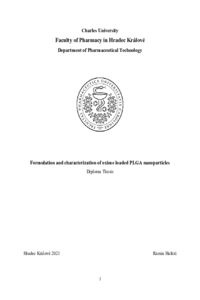Formulation and characterization of oxims loaded PLGA nanoparticles
Formulace a charakterizace PLGA nanočástic s oximy
diploma thesis (DEFENDED)

View/
Permanent link
http://hdl.handle.net/20.500.11956/126182Identifiers
Study Information System: 217251
Collections
- Kvalifikační práce [6957]
Author
Advisor
Consultant
Martiška, Juraj
Referee
Paraskevopoulos, Georgios
Faculty / Institute
Faculty of Pharmacy in Hradec Králové
Discipline
Pharmacy
Department
Department of Pharmaceutical Technology
Date of defense
2. 6. 2021
Publisher
Univerzita Karlova, Farmaceutická fakulta v Hradci KrálovéLanguage
English
Grade
Very good
Keywords (Czech)
nanočástice, rifampicin, velikost částic, zeta potenciál, enkapsulační účinnost, disoluceKeywords (English)
nanoparticles, rifampicin, particles size, zeta potential, encapsulation efficiency, dissolutionThesis title: Formulation and characterization of oxime loaded PLGA nanoparticles Author: Ramin Hafezi Supervisor: PharmDr. Eva Šnejdrová, Ph.D. Advisor: PharmDr. Juraj Martiška, Ph.D. Department: Department of Pharmaceutical Technology The diploma thesis was focused on PLGA nanoparticles (NPs) which could be loaded with oximes, prepared by a double emulsion technique, and characterised by size, polydispersity and zeta potential. The theoretical part deals with the most common methods of the NPs preparation, the polymers and stabilizers employed, and drug delivery to brain. In the experimental part the effect of various formulation factors on NP characteristics were studied: linear or branched PLGA derivative, the concentrations of polymer, the volumes of primary emulsion. Dichloromethane (DCM) or Dimethyl sulfoxide (DMSO) as solvent for polymers were used and Poloxamer 407 or Didodecyldimethylammonium bromide (DDAB) as an outer phase stabilizer were employed. By comparison among the collected results, it seemed 1% A2 in DMSO and stabilization with poloxamer 407 could be best candidate for the oxime loaded drug delivery systems as it was possible to produce nanoparticles with size from 152 to 168 nm with PDI of below 0.15. Electrostatic stability in case of using DDAB was resulted excellent and...
